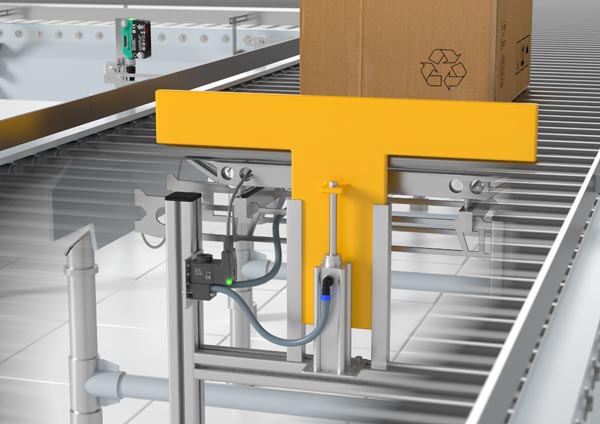The IO-Link communication standard is an integral part of modern material handling systems. This manufacturer-independent interface allows a variety of diagnostic data from sensors to be transmitted to the controller—making it an essential component of Industry 4.0 applications such as condition monitoring and predictive maintenance. Both sensors and actuators can be equipped with IO-Link, which is especially valuable for pneumatic valves used in a wide range of material handling applications. Pepperl+Fuchs offers a valve connector that can convert these actuators quickly and easily via IO-Link interface. This bit of connection technology transforms a standard valve into an intelligent valve, eliminating the need to replace the component itself. In this blog article, you will learn more about applications in which the smart valve connector can provide added value.
Applications for Pneumatic Valves in Material Handling
Pneumatic valves are often used on roller conveyors and other material handling systems—for example, to control stoppers and pushers and maintain control over the material flow.
Controlling Stoppers

To separate the conveyed products, they must be stopped at several points. First, a trigger sensor is required to detect the presence of the conveyed products. A photoelectric sensor such as those in the R20x series which is mounted on the side of the conveyor line is ideal for this purpose. The IO-Link interface makes it easy to integrate this sensor into modern communication networks. As soon as a package, pallet, or other conveyed product is detected, a pneumatic valve under the roller conveyor is activated. The valve then actuates a stopper that moves onto and between the conveyor rollers, bringing the conveyed product to a standstill.
Controlling Pushers
Pushers are used to push packages, trays, or other containers from one conveyor line to another. The photoelectric sensors in the R20x series are suitable for use as a trigger sensor at the edge of the roller conveyor in this application. As soon as the sensor detects a package, a pneumatic valve under the conveyor line actuates a pusher. This pushes the package onto a second conveyor line, which can run perpendicular or parallel to the first. The conveyed products are easily sorted, divided, and routed to the next station.
Intelligent Valve Control with the IO-Link Valve Connector
As these application examples show, pneumatic valves are essential for controlling the flow of material on roller conveyors. But what about the added value of valve connectors with IO-Link?
In material handling systems, high throughput is crucial. If critical valves fail, the conveyed products can no longer be separated and distributed correctly. In extreme failure situations, the entire line may come to a standstill—leading to high costs for the plant operator. Installing Pepperl+Fuchs IO-Link valve connectors can help avoid such costly failures.
Diagnostic Data for Condition Monitoring and Predictive Maintenance
The valve connector captures extensive diagnostic data of the connected valve—from the supply voltage and the output current to the valve motion, the temperature, and the solenoid power consumption. Individual limit values can be defined for each parameter, so that an alarm is triggered if the parameter is exceeded. Lead breakages and short circuits can also be reliably detected. In addition, the valve connector has an integrated switching cycle counter, allowing users to monitor the service life of the valve.
All process data is transmitted to the controller or cloud-based systems via an Pepperl+Fuchs IO-Link master, for example a device from the ICE* series. With this solution, plant operators can detect malfunctions early, prevent failures, and reduce conveyor system downtimes.
Power Save Mode for Increased Service Life
The valve connector is equipped with a power save mode that minimizes the need to replace field devices. Regulating the output current not only reduces the required energy by up to 70%, but also significantly lowers the temperature. The IO-Link valve connector therefore extends the service life of pneumatic valves,





